Vegetable Garden Diseases Problem Solver -- Harvest to Table
May 29, 2023, by ZadecaiMost vegetable garden diseases can be prevented and controlled. Limit disease damage by identifying diseases quickly and taking action.
Regular visits to the garden will help you spot diseased plants before the disease spreads. Choose the most effective control and then work to prevent future disease outbreaks.
Listed here are 25 common vegetable diseases. The list is in alphabetical order.

Anthracnose leaf blight
- Susceptible plants: Beans, blackberries, cantaloupe, cucumbers, melons, mint, peppers, pumpkins rhubarb, squash, tomatoes, watermelon.
- Description: Fungus disease. Overwinters on infected seeds, plant debris, or in the soil. Wet weather promotes growth; optimum growth is between 78°F and 86°F.
- Damage: Dark brown circular sunken spots on stems, leaves, pods, or fruit. The center of lesions may ooze pink spore masses. Leaf veins become reddish. Leaves may wither and fall. The plant will die back.
- Spread: Overwinters in the garden in the debris of diseased plants. Spread by wind, rain, animals, gardeners, and tools. High humidity, high rainfall, and high temperatures encourage spread. Generally found in eastern North America.
- Prevention and controls: Spray or dust with a fixed copper- or sulfur-based fungicide every 7 to 10 days. Remove and discard infected plants. Do not save seeds from infected planting areas; use western-grown seeds or seeds from areas not infected. Rotate crops. Avoid working in the garden when it is wet which can result in the spread of spores. Keep tools clean.
- Scientific name: Colletotrichum graminicola
Learn more at Anthracnose Leaf Spot

Asparagus rust
- Susceptible plants: Asparagus.
- Description: A fungus disease of massed reddish or black spores grows on asparagus ferns.
- Damage: Tiny, rust-colored spores mass on asparagus ferns. Black spores mass in late summer. Fern growth is retarded. Yield is reduced. High humidity and wet weather encourage spread.
- Spread: Rust spores are blown by the wind or carried by gardeners, tools, animals, or insects. Spores can overwinter in plant debris. Heavy dew and high humidity encourage this disease. Found throughout North America.
- Prevention and controls: Plant-resistant varieties. Cut plants to the ground at the end of each season. Remove and destroy plant debris. Keep water off of leaves. Use a preventative sulfur spray or dust every 7 to 10 days until 3 or 4 weeks before harvest.
- Scientific name: Puccinia asparagi

Bacterial blight
- Susceptible plants: Beans, peas.
- Description: Bacterial disease. Most severe where humidity is high for long periods.
- Damage: Beans: large brown blotches bordered with yellow or red on the leaves of beans. Water-soaked spots on pods. Pea stems turn purple or nearly black near the ground. Small water-soaked spots on leaves; yellow to brown spots on pods enlarge to reddish color.
- Spread: Bacteria enter plants through small openings and wounds. Spread by wind, infected seeds. Overwinters in plant debris. Most severe where humidity remains high for long periods. Found throughout mid-North America, but rarely west of the Rocky Mountains.
- Prevention and controls: Remove infected plants and discard them. Bacterial blight can not be cured. Do not save seed from the infected area. Rotate crops. Avoid working in the garden when it is wet; this may result in the spread of disease.
- Scientific name: Pseudomonas savastanoi

Bacterial wilt
- Susceptible plants: Vine crops: beans, cucumber, muskmelon, pumpkin, squash, tomato, watermelon, and corn.
- Description: A bacterial disease that clogs the capillaries transporting water and nutrients through plants. Common in moist soils; active where temperatures are greater than 75°F. Bacteria live within cucumber beetles and can be transmitted to vine crops through their feces.
- Damage: Begins with wilting of a few leaves or a small portion of the vine. Wilt spreads to the whole plant within a week or so. When the vine is cut, white ooze will flow from the stem.
- Spread Cucumber beetles, infected seedlings, soil, and water. The disease is most severe in the central, southern, and eastern United States.
- Prevention and controls: Remove and destroy infected plants before the disease spreads. Control cucumber beetles with rotenone or sabadilla. Wash hands and clean tools with a bleach solution.
- Scientific name: Ralstonia solanacearum
Learn more at Bacterial Leaf Spot Disease
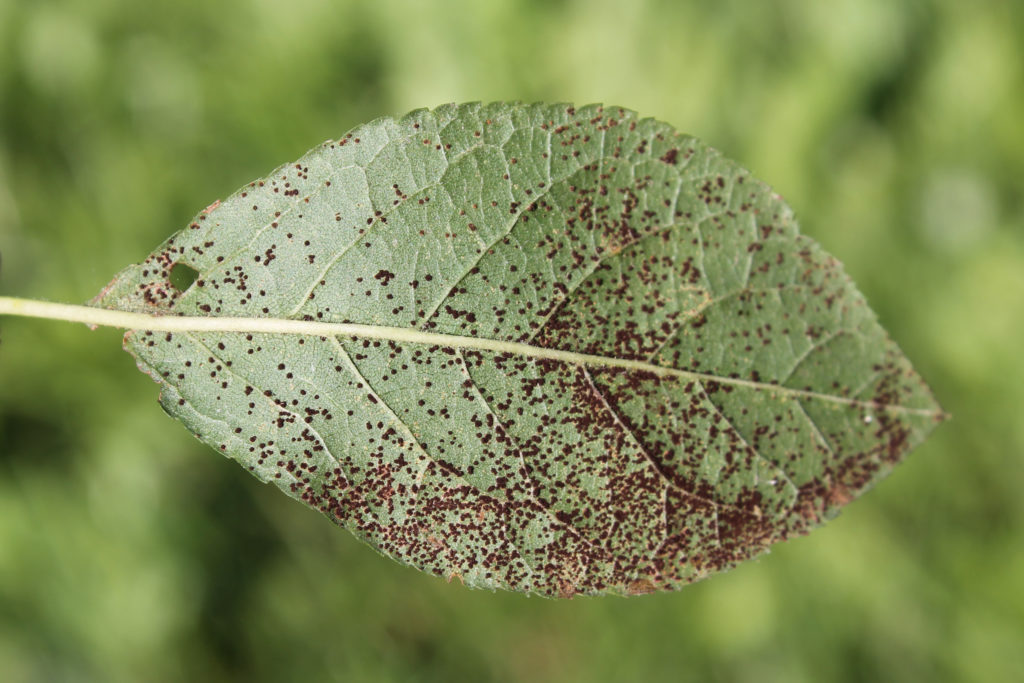
Bean rust
- Susceptible plants: Beans.
- Description: A fungus disease of reddish-orange to brown spore masses that cause leaves to drop.
- Damage: Numerous, tiny, rust-colored spots appear on the leaves of mature plants. The fungus may first appear as whitish-raised spots on the underside of leaves. Leaves turn yellow and die. High humidity and wet weather encourage spread.
- Spread: Rust spores are blown by the wind or carried by gardeners, tools, animals, or insects. Spores can overwinter in plant debris. Heavy dew and high humidity favor this disease. Found throughout North America.
- Prevention and controls: Plant disease-resistant varieties. Rotate crops. Remove and destroy plant debris. Keep water off of leaves. Spray or dust with a sulfur spray every 7 to 10 days until the disease is controlled.
- Scientific name: Uromyces appendiculatus
Learn more at Rust Fungus Disease

Blackleg
- Susceptible plants: Potatoes.
- Description: A fungus disease resulting in dry rot. Carried on seed and lives in the soil. Most severe in humid or rainy weather.
- Damage: Sunken areas develop on the lower stem, blacken, and girdle the stem. Gray spots and specks with black dots appear on leaves and stems. Leaf edges wilt and turn bluish or red. The plant wilts and dies.
- Spread: Infected seed. Spores can over-winter for 1 or 2 years in plant debris. Rain can spread spores. Tools. Black leg is found in central, southern, and eastern North America.
- Prevention and controls: Fixed copper fungicides. Remove and destroy infected plants. Rotate crops. Clean up plant debris.
- Scientific name: Pectobacterium atrosepticum
Black rot
- Susceptible plants: Broccoli, Brussels sprouts, cabbage, cauliflower, Chinese cabbage, collards, kohlrabi, turnips.
- Description: The bacterial disease is encouraged by wet weather.
- Damage: Infects young and mature plants. Seedlings turn yellow and die. Mature plants develop wedge-shaped yellow regions and margins that expand to the center of the leaf. Leaves brown, die, and drop. Vascular tubes in plants turn black and foul-smelling. Heads of plants may rot.
- Spread: Bacteria overwinters in soil and plant debris. Rain, surface water, and insects can spread disease. Found in the central, southern, and eastern United States.
- Prevention and controls: Cannot be remedied. Remove and destroy infected plants. Clean garden in fall. Apply micronized sulfur to nearby but uninfected plants every 7 days until harvest.
- Scientific name: Xanthamonas campestris pv campestris
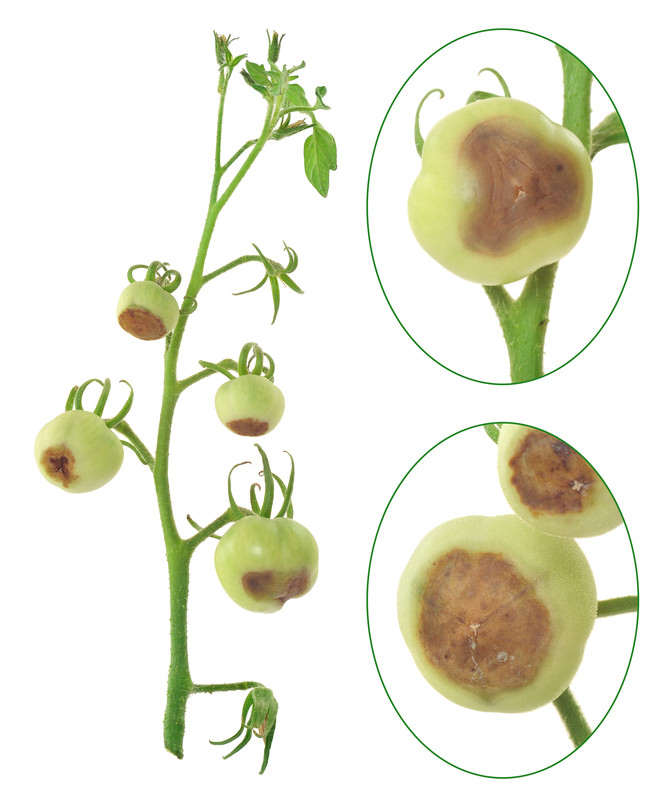
Blossom end rot
- Susceptible plants: Tomatoes, peppers, watermelons, squash.
- Description: Environmental factors cause blossom end rot, not a pathogen. Irregular watering–water, then drought, then water, then drought–particularly when the fruit is forming is one cause. Too much water may also cause blossom end rot. A calcium imbalance in the soil may also result in insufficient water uptake.
- Damage: Cells at the end of the blossom fail to receive sufficient water; the blossom end of the fruit becomes dry, sunken, and leathery in tomatoes. Peppers can turn brown-black or light-colored and papery at the blossom end. Half of each fruit may be affected.
- Prevention and controls: Maintain even soil moisture. Mulch and cultivate only shallowly during drought. The soil pH should be between 6.0 and 7.0, add limestone which contains calcium if the pH is below 6.0.
- Scientific name: Blossom end rot is caused by a lack of calcium in the fruits. Blossom-end rot of tomato (Lycopersicon esculentum Mill.)

Botrytis rot — neck rot
- Susceptible plants: Onions, chives, garlic, marjoram, oregano, rosemary, thyme. Sweet onions are most susceptible. Neck rot is a post-harvest disease; pathogens enter the plant through soft tissue injury.
- Description: Bulbs start rotting 4 to 8 weeks after they are harvested.
- Damage: Rotted area looks water-soaked; tissue turns brown and dry up. Gray spores appear and grow. Tissue takes on a sunken appearance and becomes spongy.
- Prevention and controls: Plant disease-resistant varieties. Dry bulbs fully. Plant clean seed; the disease can be seed-borne.
- Scientific name: Botrytis cinerea

Clubroot
- Susceptible plants: Broccoli, Brussels sprouts, cabbage, cauliflower, Chinese cabbage, collards, kohlrabi, and turnips.
- Description. A fungal disease that lives in the soil and enters a plant through its roots.
- Damage: Roots become enlarged and swollen (clubbed) and begin to malfunction. They may crack or rot. Young plants are killed. Older plants have reduced yields. Plants are yellow and wilt during the day; leaf heads are small. Plants may recover from wilt at night.
- Spread: Fungal spores spread from infected plants by wind, water, or tools. Spores survive for at least 7 years.
- Prevention and controls: Remove diseased plants from the garden. Use a 4-year rotation. Clubroot thrives in acid soil; add lime if the soil pH is below 6.0. Raise the pH to 7.2. Grow seedlings in a sterile soil mix.
- Scientific name: Plasmodiophora brassicae

Corn smut
- Susceptible plant: Corn
- Description. Fungus disease causes gray-white galls on corn seedlings, stalks, and ears.
- Damage: Whitish-gray galls appear on the ear or other parts of the corn plant. Galls mature, turn black, and burst releasing thousands of spores.
- Spread: Fungal spores are spread by wind or transmitted by humans and tools. Warm dry weather encourages spread.
- Prevention and controls: Plant disease-resistant varieties. Remove and destroy galls before galls break open. Apply sulfur- or copper-based fungicide every 7 to 10 days. Remove all crop debris. Rotate crops. Do not compost diseased plants.
- Scientific name: pathogenic fungus Ustilago maydis
Curly top
- Susceptible plants: Beans, muskmelons, pumpkins, tomatoes, watermelons.
- Description: Curly top is a viral disease. Leaves pucker, curl, and twist. Plant growth is stunted.
- Damage: Leaves curl and yellow. Plants become stunted. Fruit does not set or yield is reduced.
- Spread: Whiteflies and leafhoppers transmit the virus.
- Prevention and control: Curly top cannot be cured. Plant disease-resistant varieties. Remove and destroy infected plants. Control weeds, insects, and nematodes. Cover plants with row covers if leafhoppers are a problem in the garden.
- Scientific name: pathogenic plant virus of the family Geminiviridae

Damping off
- Susceptible plants: Basil, beans, broccoli, Brussels sprouts, cabbage, carrots, cauliflower, celery, Chinese cabbage, chives, collards, kohlrabi, lettuce, marjoram, onions, savory, spinach, tomatoes.
- Description: Sclerotinia fungus disease lives in the soil, particularly where are high humidity and warm temperatures.
- Damage: The base of the stem near the soil is pinched and bent over causing seedlings to die.
- Spread: The fungus lives in the soil, primarily in seed beds. The fungus can spread via transported soil or tools. The disease is present throughout North America.
- Prevention and controls: Plant in well-drained soil. Use a sterile seed-starting mix. Water seedlings from below. Allow the soil surface to dry before nightfall. Use a fan to keep the air circulating.
- Scientific name: Phytopythium vexans
Learn more at Damping Off Disease
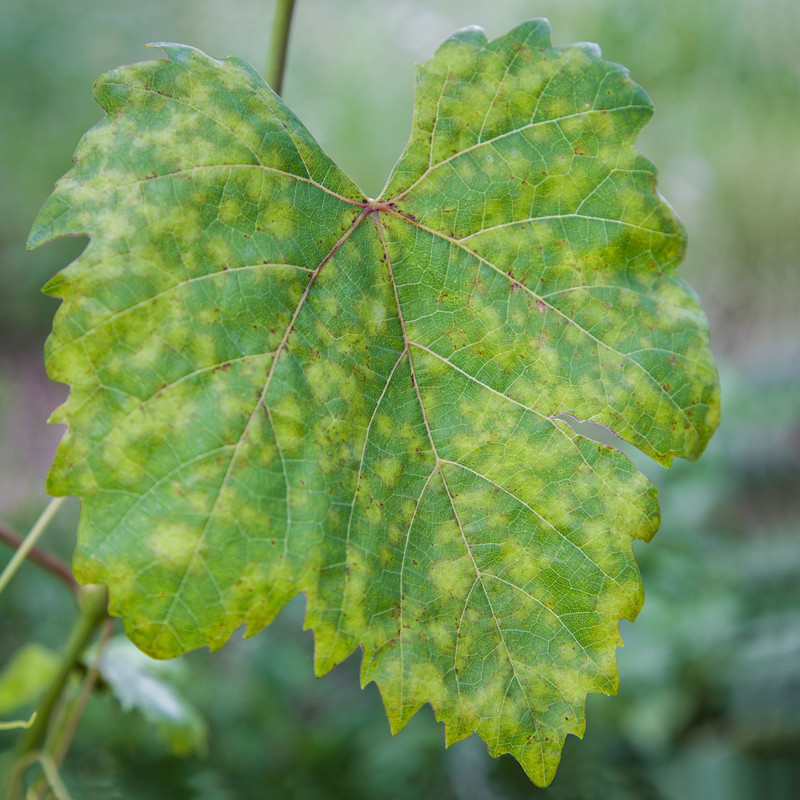
Downy mildew
- Susceptible plants: Beans, cauliflower, chard, cantaloupes, cucumbers, lettuce, melons, onions, pumpkins, radishes, spinach, squash, tarragon, turnips, and watermelons.
- Description. A fungal disease that thrives where nights are wet and cool and days are warm and humid. The fungus overwinters in crop and garden debris and spreads through infected seeds.
- Damage: Yellowish to light green areas on the surface of older leaves. A felt-like, whitish growth will develop on the underside of the leaves. A white, felt-like growth forms on the pods of beans, with a possible reddish discoloration around the white areas. Most common in the eastern US because high humidity and cool temperatures promote spread.
- Spread: Spores can be carried by insects, wind, rain, and tools. Spore production is greatest where temperatures are cooler than 65°F and humidity is near 100 percent. Common in the eastern United States where there are cool temperatures and high humidity.
- Prevention and controls: Plant disease-resistant varieties. Destroy infected plants and all crop debris. Rotate crops each year. Avoid wetting the tops of plants when watering. Spray or dust with a copper-based fungicide every 7 to 10 days until harvest.
- Scientific name: Peronospora effusa

Early blight
- Susceptible plants: Celery, potatoes, tomatoes.
- Description: Fungus disease that overwinters in plant debris.
- Damage: Irregular dark spots appear on older leaves followed by a series of concentric dark rings. Spots usually appear on older leaves first. Defoliation can follow. Collar rot at soil level girdles the stems of tomatoes. Cankers or decay can form on fruit and tubers. Warm, wet weather can cause the disease to spread rapidly over the entire plant. Yield is reduced.
- Spread: Spores overwinter in plant debris. They can be spread by wind or insects. Spread is encouraged by heavy dew, rainfall, and warm temperatures. Early blight is found throughout North America.
- Prevention and controls: Plant healthy seed potatoes and tomato seedlings. Rotate crops. Keep the garden free of plant debris. Spray or dust with copper-based fungicide every 7 to 10 days.
- Scientific name: Alternaria solani
Learn more at Early Blight Fungus Disease
Fusarium wilt
- Susceptible plants: Cabbage (called fusarium yellows), celery (called yellows), melons, peas (pea wilt), potatoes, spinach, tomatoes, turnips, and watermelons.
- Description: Fungal disease which infects plant vascular tissues. The fungus lives in the soil and infects plants through the roots. The fungus prefers warm, dry weather with soil temperatures between 60°F and 90°F.
- Damage: Leaves and stems turn yellow beginning from the base of the plant. Plants wilt and become stunted. Yields are reduced. Plants may die.
- Spread: Spores can live in the soil for up to 20 years. Water and striped cucumber beetles can carry the disease. Fusarium wilt is common throughout the United States, particularly from the Rocky Mountains east.
- Prevention and controls: Plant disease-resistant varieties. Rotate crops. Remove and destroy infected plants. Fungicides are not effective.
- Scientific name: Fusarium oxysporum f. sp. Lycopersici

Late blight
- Susceptible plants: Celery, potatoes, tomatoes.
- Description: Fungus disease attacks plants after they blossom.
- Damage: Water-soaked round spots or patches form on leaves. Leaf spots turn brownish black; a white fungal growth may form on the underside of leaves. Leaf stalks and stems may become soft and blighted.
- Spread: Fungus overwinters in plant debris. Seed, water, and wind can carry the disease. Rainy, foggy weather with temperatures between 70°F and 80°F during the day and 20 degrees cooler at night are favorable to late blight.
- Prevention and controls. Plant disease-resistant varieties. Plant clean seed potatoes. Rotate crops. Keep the garden clean of plant debris. Spray or dust with copper-based fungicide every 7 to 10 days.
- Scientific name: Phytophthora infestans
Learn more at Late Blight Fungus Disease

Leaf spot
- Susceptible plants: Blackberries, parsley, tomatoes.
- Description: Fungus or bacteria disease attacks leaves; also called Septoria leaf spot or Septoria blight.
- Damage: Leaves are dotted with small spots, gray on tomatoes or tan to light brown on blackberries. Spot may have purplish borders. As spots enlarge, black dots will appear in the center. The disease may cause leaves to drop.
- Spread: Seeds, rain, and wind will transmit the disease, also transmitted by working with wet plants. Occurs in the central and eastern United States.
- Prevention and controls: Plant disease-resistant varieties. Rotate crops. Keep the garden free of plant debris. Apply copper dust or liquid copper spray every 7 to 10 days.
- Scientific name: Some of the fungi associated with leaf spots are Alternaria, Ascochyta, Blumeriella, Cercospora, Colletotrichum, Entomosporium, Gnomonia, Guignardia, Mycosphaerella, Phyllosticta, Septoria, Tubakia, and Venturia. Common bacteria associated with leaf spots are Pseudomonas and Xanthomonas.
Learn more at Septoria Leaf Spot
Alternaria leaf spot
- Susceptible plants: Cabbage family crops, squash family crops, carrots strawberries.
- Description: Fungual disease; Alternaria leaf blight is particularly problematic for plants in the cabbage and squash families. Strawberries and carrots are also susceptible. When Alternaria infects broccoli and cauliflower plants, it may cause brown areas on the heads.
- Damage: Small yellow spots that appear first on older leaves are a symptom of this fungal blight. These spots gradually enlarge and become dark-colored areas filled with concentric rings.
- Spread: As with most fungal diseases, Alternaria thrives in warm, wet weather. The spores are spread by wind and are able to enter leaf tissues when the foliage has been consistently moist for 24 hours. The fungus overwinters on plant debris in and around the garden, and can also be transmitted by seed.
- Prevention and controls: Remove infected plants and discard them. Bacterial diseases can not be cured. Do not save seed from the infected area. Rotate crops. Avoid working in the garden when it is wet; this may result in the spread of disease.
- Scientific name: Alternaria alternata

Mosaic virus
- Susceptible plants: Beans, cucumbers, lettuce, melons, peppers, potatoes, raspberries, squash, tomatoes, and watermelons.
- Description: Mosaic, common mosaic, and tobacco mosaic: viral diseases that stunt plant growth. Mosaic overwinters in perennial weeds and is transmitted by aphids and cucumber beetles.
- Damage: Leaves become mottled yellow and green and may curl and crinkle. Plants are stunted. Yields are reduced. Infected fruit is mottled, bumpy, and misshapen and will ripen unevenly.
- Spread: Mosaic cannot be cured. Aphids and spotted or striped cucumber beetles can spread mosaic virus to susceptible plants. Mosaic over-winters in perennial weeds. The virus can also be spread by people working with infected plants. Mosaic virus can be found throughout North America.
- Prevention and controls. Mosaic can not be cured. Remove and destroy diseased plants. Plant healthy seeds. Plant mosaic-resistant varieties. Keep perennial weeds out of the garden. Control aphids and cucumber beetles with insecticidal soap or a light horticultural oil spray. Do not work with plants when they are wet.
- Scientific name: a member of the family Tobamoviridae and belongs to the genus Tobamovirus, which is a plant pathogenic virus.
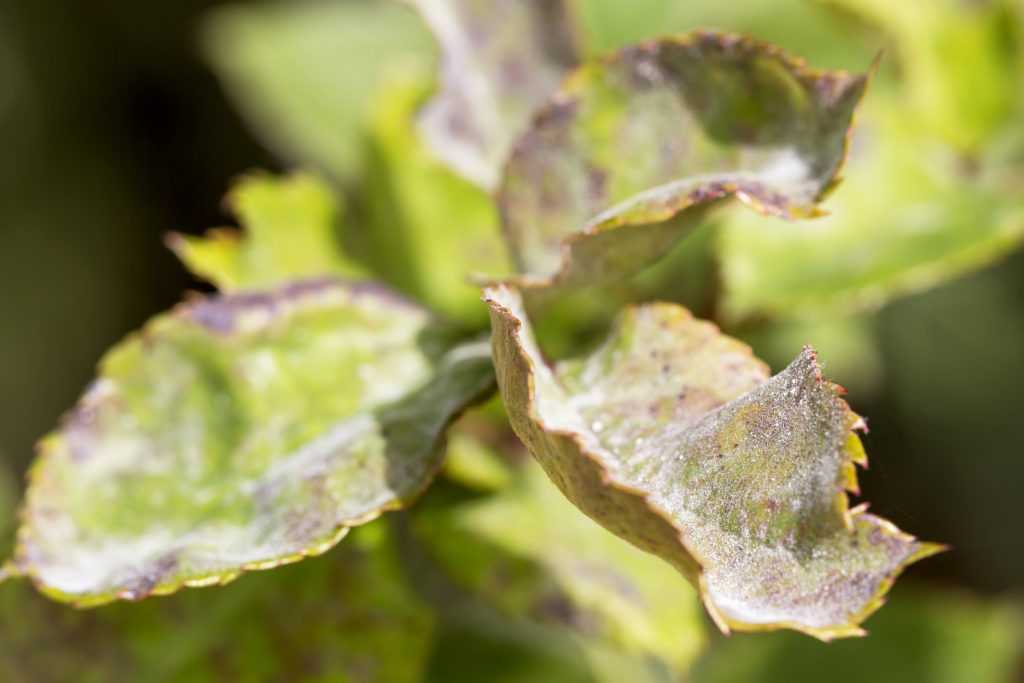
Powdery mildew
- Susceptible plants: Apples, blackberries, blueberries, cherries, cucumbers, melons, peas, plums, pumpkins, raspberries, sage, squash, strawberries, tarragon, and watermelons.
- Description: Fungus disease that lives in soil and plant debris. Encouraged by low soil moisture and high humidity.
- Damage: Gray, white, or brown velvety mold grows on surfaces of leaves and young stems. Mold spreads to the whole plant. Leaves may yellow and curl then the plant may wither and die.
- Spread: Overwinters in plant debris, also in apple and plum buds. Spores are spread by water and wind. Found throughout North America.
- Prevention and controls: Plant disease-resistant varieties. Remove and destroy infected plants and keep the garden clean of plant debris and weeds. Allow space between plants for air circulation. Rotate crops. Disinfect garden tools clean; use one part bleach to four parts water solution. Spray or dust with sulfur or copper-based fungicide every 7 days.
- Scientific name: Podosphaera xanthii and Erysiphe cichoracearum

Root rot
- Susceptible plants: Beans, carrots, corn, peas.
- Description: Fungus disease lives in the soil and affects the plant vascular system.
- Damage. Leaves are yellow and lower stems wither. Plants grow unhealthy. Roots covered with mold. Plants do not respond to water and fertilizer.
- Spread: Fungus lives in the soil. It can be spread with infected soil and by water. Clean tools after use.
- Prevention and controls: Remove and destroy infected plants. Plant in well-drained soil. Water less frequently but for longer periods so that water reaches deep in the soil. Rotate crops. Raise beds if the soil is too wet. Control harmful nematodes with beneficial nematodes.
- Scientific name: Phytophthora megasperma
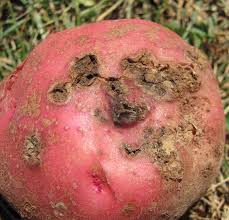
Scab
- Susceptible plants: Apricots, beets, cucumbers, melons, peaches, potatoes, pumpkins, squash, watermelons.
- Description: Fungus disease causes scab-like growth in cucumbers, potatoes, watermelons, peaches, and other fruits.
- Damage: Dark, sunken, or water-soaked spots on vegetable leaves that result in wilt. Stems can develop cankers. Fruits develop gray, sunken spots. Potatoes develop brown, rough, irregular spots or lesions. Dark, greenish spots appear on half-grown apricots and peaches.
- Spread: Scab over-winters in garden debris and soil. It is transmitted to plants by the wind. Cool, humid weather encourages spread. Scab is found throughout North America.
- Prevention and controls: Plant disease-resistant varieties. Rotate crops. Remove and destroy infected vegetable plants. Keep the garden free of plant debris. For fruit trees, use sulfur spray or dust 2 to 3 weeks after petals drop.
- Scientific name: Cladosporium cucumerinum

Sunscald
- Susceptible plants: Tomatoes, peppers, apples, cherries.
- Description: Sunscald is an environmental disorder caused by too much exposure to the sun especially during hot, dry weather.
- Damage: Large, irregular, paper-like white spots on fruit after prolonged exposure to the sun. White or reddish spots may develop on leaves. Dark molds may grow on scalded areas. Sunscald can occur when leaves drop due to unrelated diseases or environmental disorders.
- Prevention and controls: Control diseases that cause leaves to drop exposing fruit or stems and trunks to the sun. Plant varieties resistant to diseases which can result in leaf drop. Plant varieties with heavy foliage. Fertilize and water properly.
- Scientific name: Sunscald, a noninfectious disease of pepper and tomato, is caused by sudden exposure of the fruit to intense direct sunlight and is most serious during periods of extreme heat.
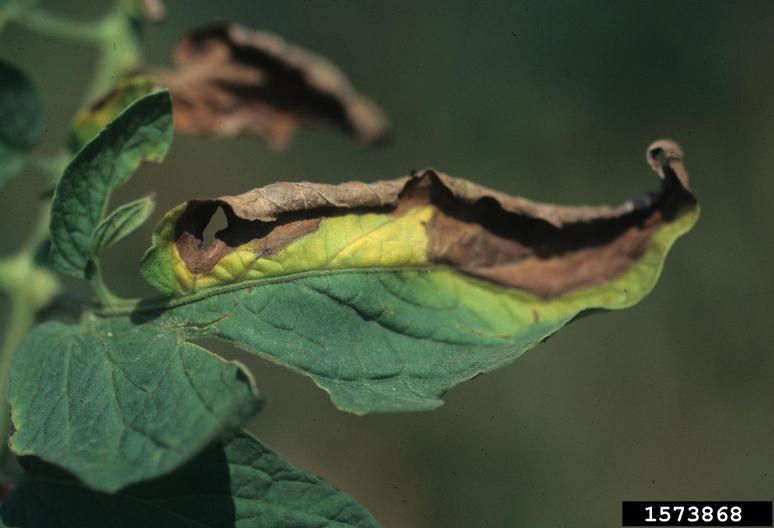
Verticillium wilt
- Susceptible plants: Apricots, blackberries, cherries, eggplants, melons, mint, okra, peaches, plums, potatoes, raspberries, rhubarb, sage, strawberries, and tomatoes.
- Description: Fungal infection of vascular tissues causing wilting. Soil-dwelling fungus infects plants through plant roots.
- Damage: Leaves and stems turn yellow. Plants wilt. Stems turn brown. Plant growth is stunted, and yields are reduced.
- Spread: Verticillium wilt lives in the soil and overwinters in plant debris. It can spread during cultivation or by running water. Perennial weeds can host verticillium wilt and transmit it to crops. Fungus develops during cool, humid weather.
- Prevention and controls: Plant disease-resistant varieties. Practice 4-year rotation. Use a sulfur fungicide every 7 to 10 days to control disease.
- Scientific name: Verticillium dahliae

Yellows – aster yellows
- Susceptible plants: Broccoli, Brussels sprouts, cauliflower, celery, Chinese cabbage, collards, kohlrabi, lettuce, spinach.
- Description: Disease caused by mycoplasmas bacteria.
- Damage: Leaves turn yellow, then brown, then drop. The plant becomes stunted. Yields are reduced.
- Spread: Mycoplasmas overwinter in weeds and other perennial plants. The disease is spread by leafhoppers.
- Prevention and Control: Yellows can not be cured. Remove and destroy infected plants. Keep weeds which host leafhoppers cut. Control leafhoppers with diatomaceous earth, insecticidal soap, liquid rotenone or pyrethrum, or horticultural spray oil.
- Scientific name: Fusarium oxysporum f. sp. conglutinans
0 comments